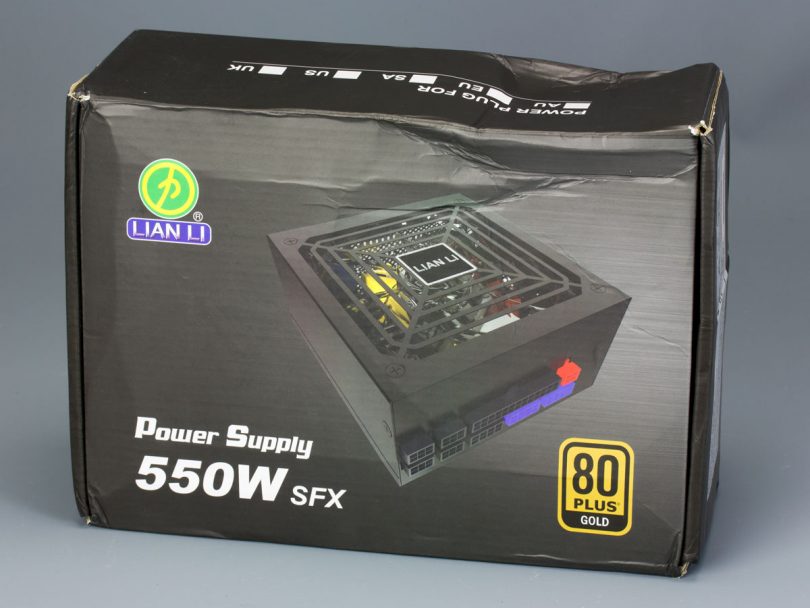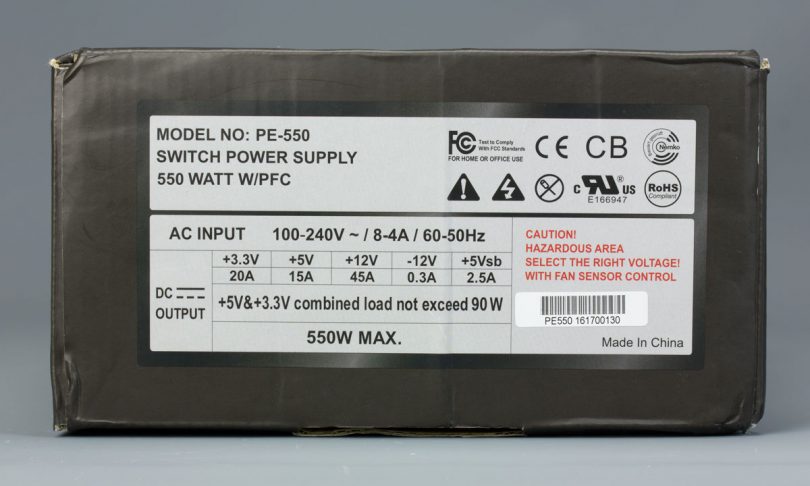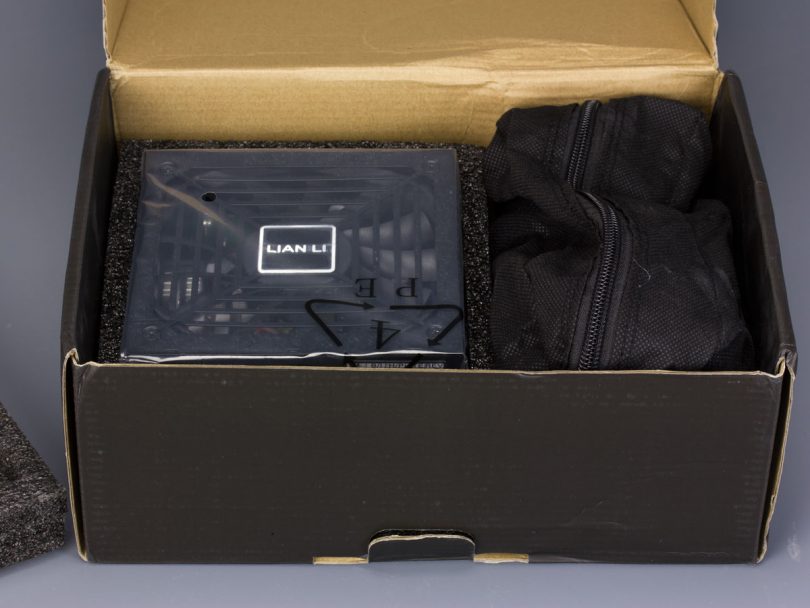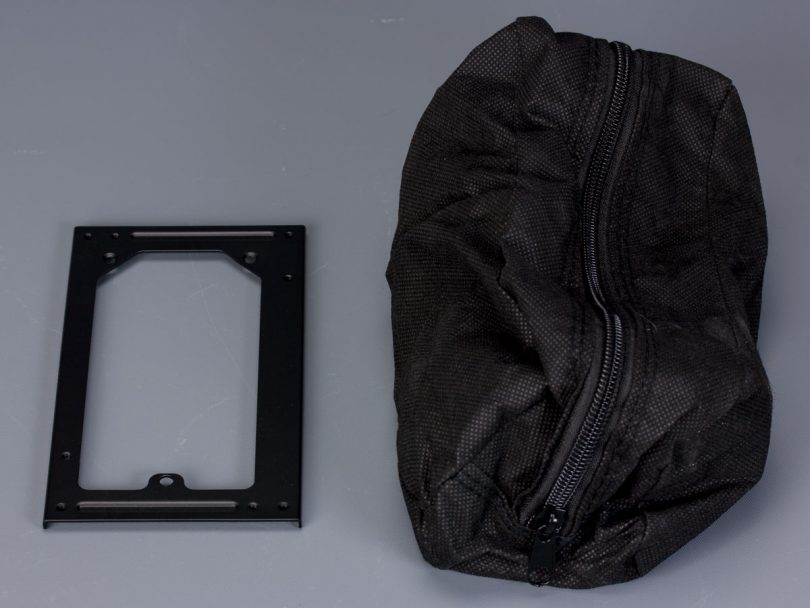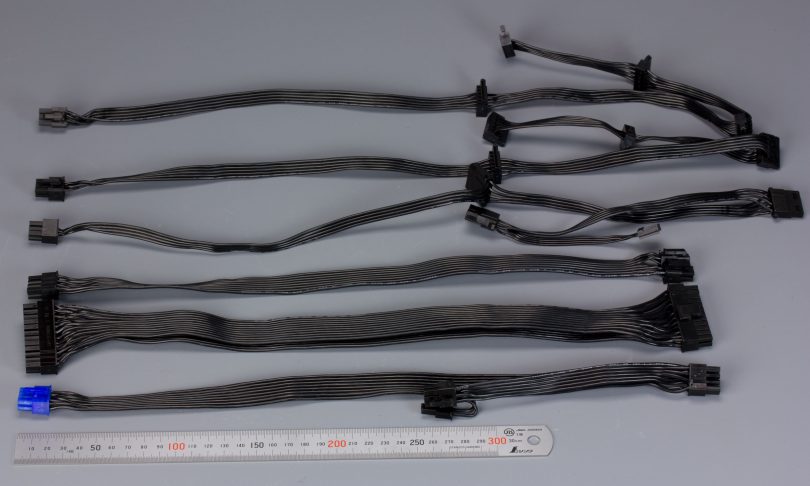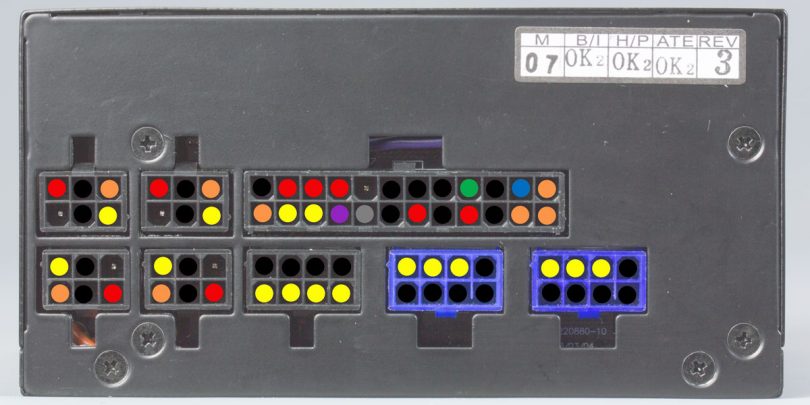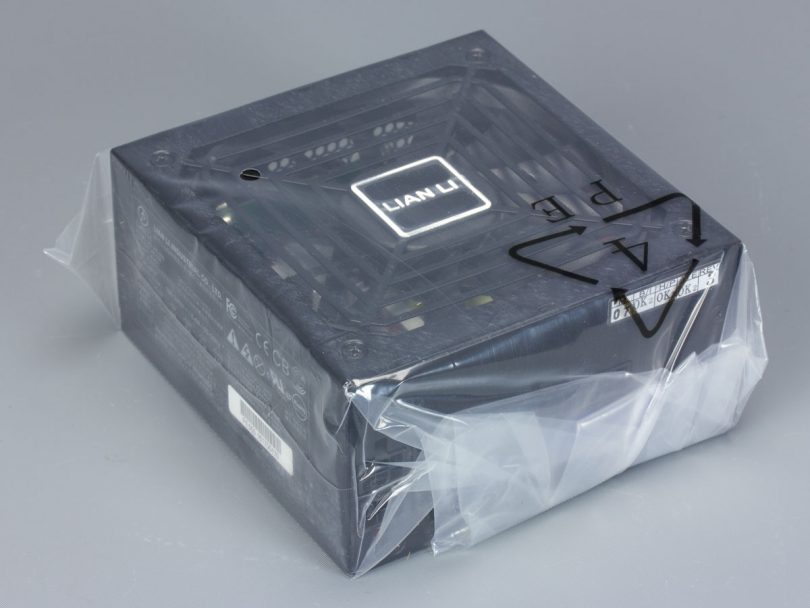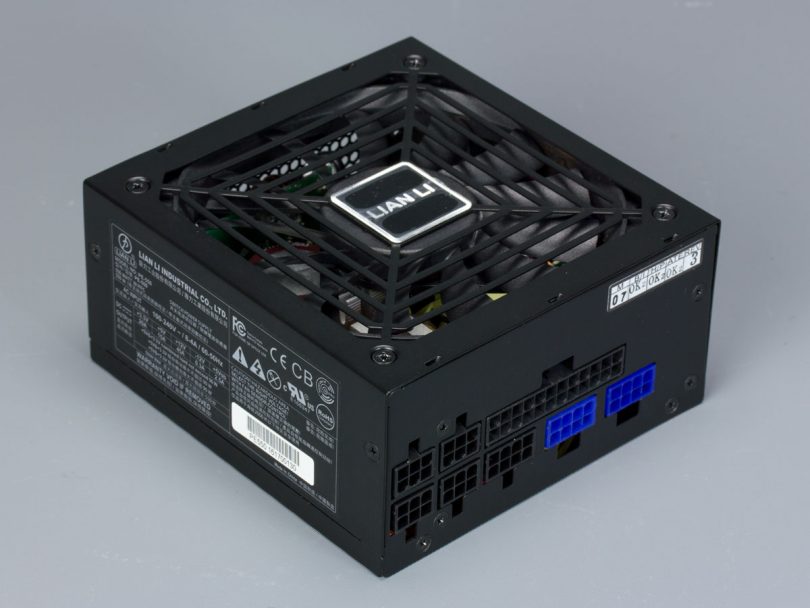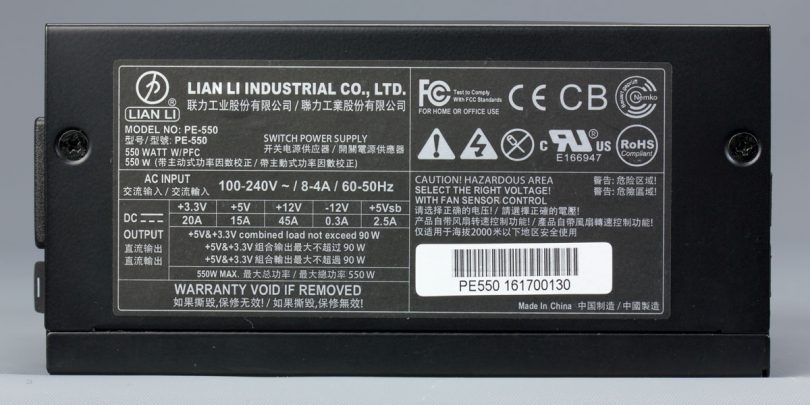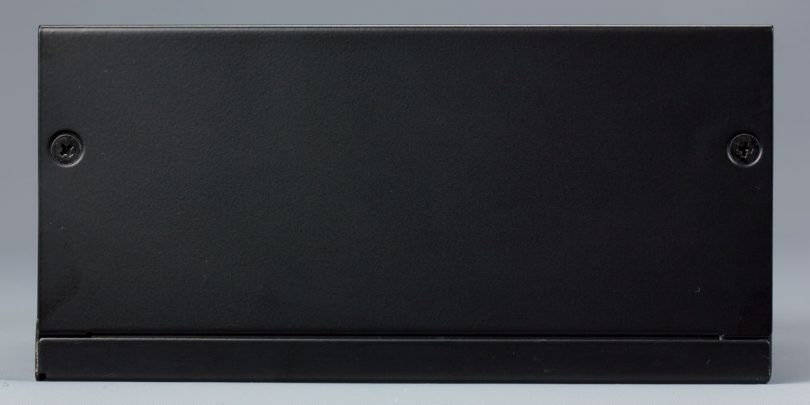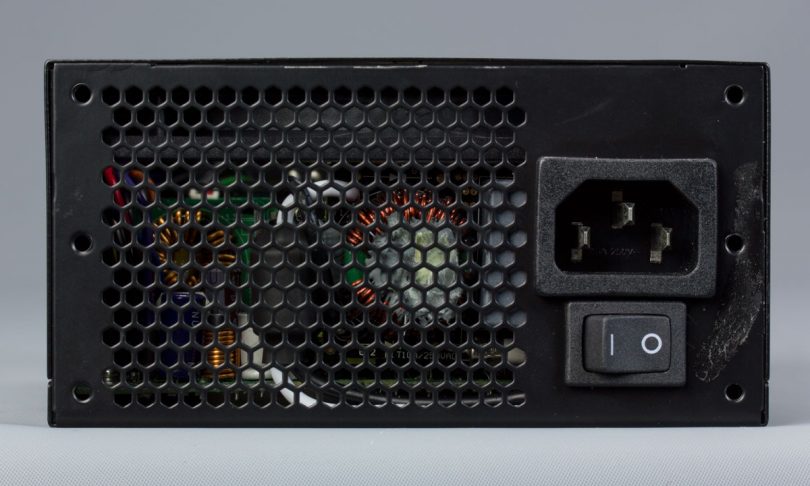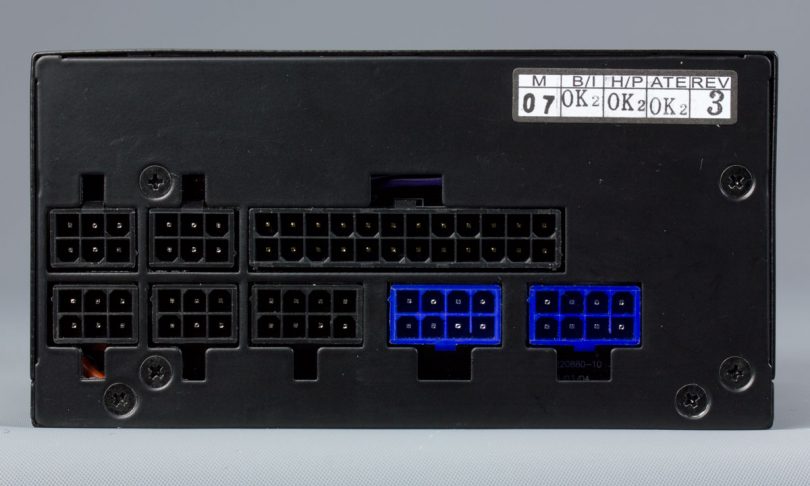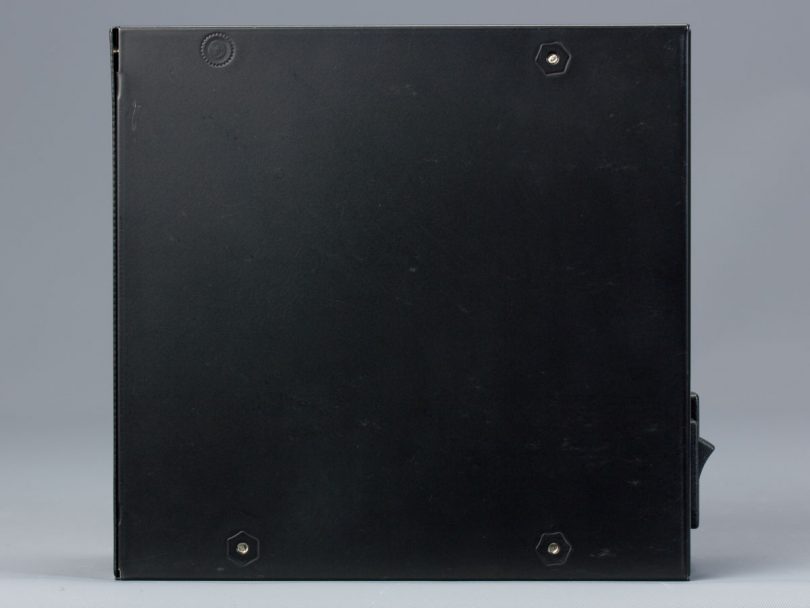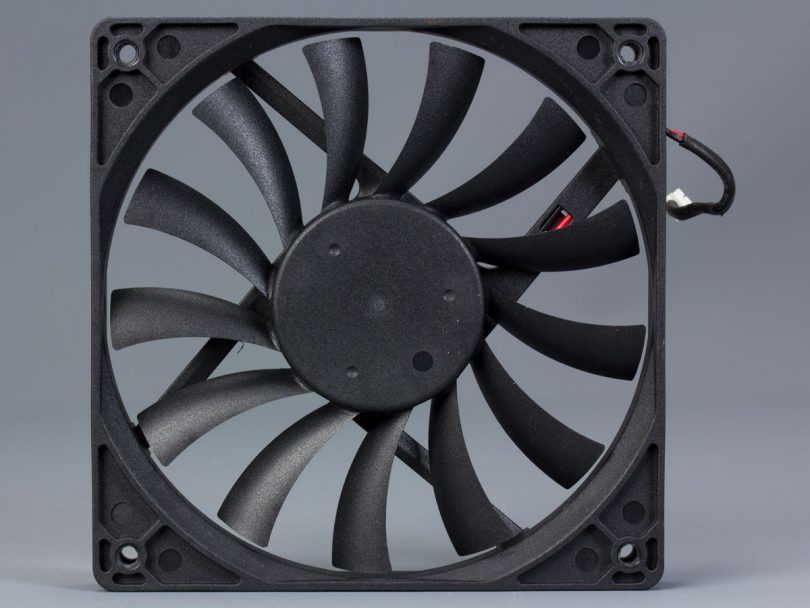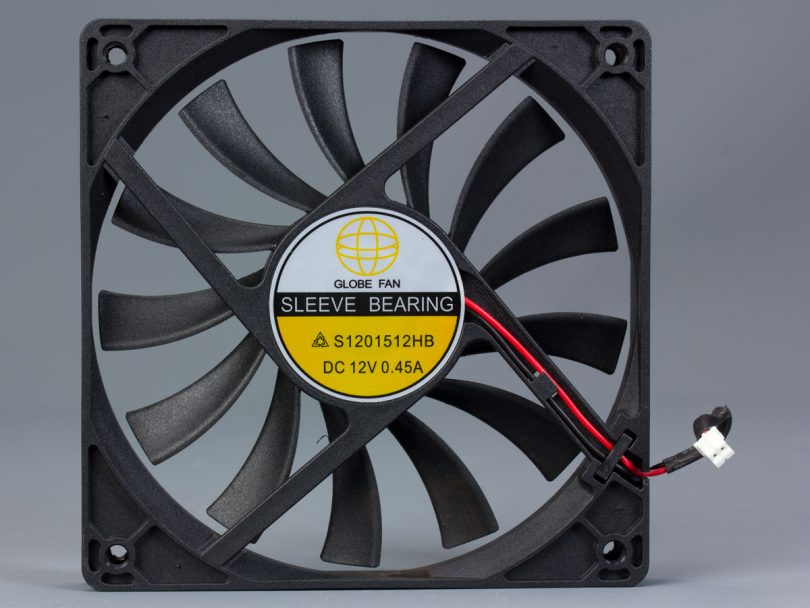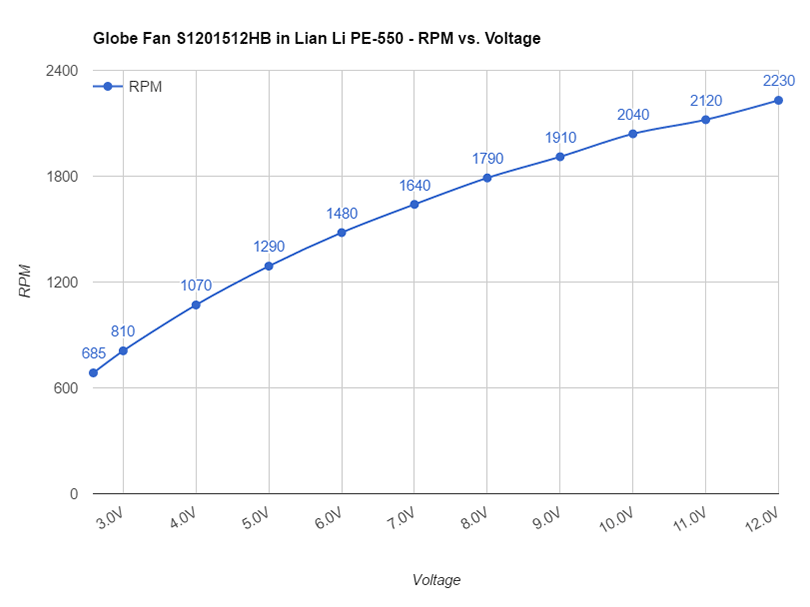Welcome to another SFX-L power supply review! Today, we’re looking at the Lian Li PE-550, the second SFX-L unit in Lian Li’s SFX-L portfolio after the PE-750 I reviewed earlier this year. It is a 550W unit, Gold-rated, fully-modular, and features a slim 120mm cooling fan.
And can I just say how awesome it is that this is the third SFX-L power supply I’ve reviewed in six months! It’s especially amazing considering the state of SFX/SFX-L PSUs even just two years ago.
A disclaimer first before we get started: SFF Network does not currently possess the expertise or equipment to fully test the electrical performance of PC power supplies, and as such, this article should not serve as the sole data point in determining whether to purchase this product. We’ll be able to contextualize the utility and experience of using this unit with others in the market place, but we’d suggest having our own review supplement those by others who have the hardware and capability to do more thorough analysis of electrical performance, especially at higher wattages.
The Box
For some reason Lian Li decided to use the PSU box as the shipping box for my review unit, so it arrived after its journey across the Pacific looking a little rough. I’d like to say this wouldn’t be an issue for retail units, but unfortunately I’ve seen Amazon do the same thing a few times.
Anyways, like the PE-750 (and unlike pretty much every other other company’s power supplies), the packaging for this is devoid of marketing material – so I won’t spend much more time on the subject.
Of note though, the picture on the front is of the PE-750 and not the PE-550. Also, Lian Li correctly says this is a SFX-L unit on their website, but right on the front of the box it says “SFX” instead. Granted, the photo will hopefully ensure that anyone casually glancing isn’t led astray, but hopefully Lian Li can get the packaging corrected in a future revision to avoid confusion.
Moving on, there is the load table and some basic information, like the model number and certifications, on one side of the box.
So this unit can do almost the full rated wattage on just the 12V. This is always nice to see, considering how 12V-heavy modern components are.
Opening up the box, it looks like I got lucky and that big dent is just where the PSU cable bag is. Further, the PSU was well-protected by the block of closed-cell foam it’s enclosed in.
Accessories
My review unit did not come with a manual, but the same cable bag and painted ATX adapter bracket as the PE-750 is here. Included but not pictured are some mounting screws.
The manual is available for download but there is some errant copy/pasting from the PE-750 again. It’s fairly minor this time though, with the manual showing the modular power connectors as protruding 4.7mm, when in actuality they’re flush with the housing. (That’s the correct direction to make an error in, at least)
Cables
Cable lengths as follows from top to bottom:
- 4x SATA (300mm / 200mm / 100mm / 100mm)
- 4x SATA (300mm / 200mm / 100mm / 100mm)
- 3x 4-pin Molex + 1x Floppy (300mm / 200mm / 200mm / 100mm)
- 4+4-pin CPU (400mm)
- 24-pin motherboard (400mm)
- 2x 6+2-pin PCIe (400mm / 150mm)
(The first number is from the PSU-side to the first connector, and the second number is from the first connector to the second, and so forth.)
The PE-550 comes with ribbon-style, flexible cables like the newer SilverStone SFF power supplies. Cable lengths are the same as the PE-750, which is to say that they’re appropriate for a SFX-L unit. I do wish the floppy power connector was split off into an adapter rather, than being hardwired to the 4-pin Molex strand, but otherwise I think the number and types of connectors is suitable for the wattage and form factor.
[mks_col]
[mks_one_third]
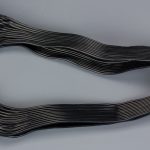
[/mks_one_third]
[mks_one_third]
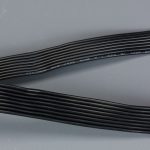
[/mks_one_third]
[mks_one_third]
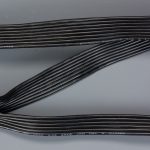
[/mks_one_third]
[/mks_col]
[mks_col]
[mks_one_half]
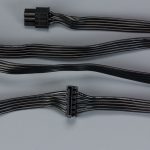
[/mks_one_half]
[mks_one_half]
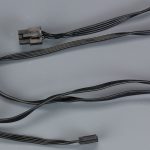
[/mks_one_half]
[/mks_col]
Pinout
The pinout on the PE-550 and PE-750 is identical, other than the fact that the 550W lacks the extra 4-pin sense connector that the 750W has. This is also the same pinout SilverStone uses for their modular SFF units, so the cables should be interchangeable!
The arrangement of the ground wires on the Lian Li PCIe cable differs slightly, but that should not matter. I say “should” because you should always double-check when using non-original PSU cables, to make sure nothing will get fried, rather than trusting some random person on the internet.
The Power Supply
Like the PE-750, Lian Li is not putting any kind of label or sticker on the unit (like other manufacturers do) warning the user that this unit is semi-fanless, and that the fan not turning on at first is intentional. This is problematic because nowhere (website, manual, packaging, etc.) do they mention that the unit is semi-passive. So while I appreciate Lian Li giving SilverStone some competition in the SFX-L space, I really worry they’re setting themselves up for a high return rate with this and the packaging issues I mentioned earlier.
On a more positive note, the PE-550 itself is a sharp looking unit with completely flush modular connectors! This is great news for NCASE M1 owners in particular because the little bit of extra space gained by this (in combination with the flexible cables) should prevent the wires from pressing down on the back of an installed video card. While it’s generally not possible to provide this on high-wattage SFX-L power supplies (due to the lack of internal space), I hope flush connectors becomes a trend for the lower wattage units, because every millimeter counts in tight SFF builds.
The label on the side has the typical load table and warnings, though the same nonsensical “SELECT THE RIGHT VOLTAGE!” warning is here even though neither this nor the PE-750 have input voltage selectors.
Over on this side we got nada.
I like that Lian Li kept the position and orientation of the AC inlet consistent between this and the 750W. The wide variation in where the inlet is located and which direction it’s facing causes issues with cases like the aforementioned NCASE M1, where the angled C13 power connector won’t fit easily with certain combinations of inlet position and orientation. So consistency makes it easier to figure out which PSUs will or will not fit in cases like that. The PE-550/PE-750 won’t have any issues in the M1 (v2 or later), by the way.
It may look like long screws in the bottom mounting holes could interfere with the PCB from this perspective, but that is not the case. The shot of the internals later will make it clear, but the main PCB is inset from the rear of the housing a good distance, so all six mounting holes are safe for use with long screws.
As mentioned earlier, the modular connectors are flush with the housing. Interestingly, there are more connectors available than there are cables provided – in particular, there is one extra peripheral connector (the 6-pins) and one extra PCIe connector (the blue 8-pins). The black 8-pin is for the CPU power cable.
Lian Li went with the same distinctive concentric square vent pattern for the 550W as they did on the 750W. It’s visually unique and minimizes airflow restriction, so no complaints from me on that.
There is yet another discrepancy between Lian Li’s marketing and the actual unit, though. The fan in the pictures of the PE-550 on Lian Li’s website is visually identical to what’s in the PE-750, but what it ships with is different… I hate to keep harping on these issues but customers who go to the effort of checking the website and other available documentation prior to making a purchase should not be in for a surprise by what they actually receive. So it’s necessary for me to mention it.
Testing
As mentioned at the beginning of the review, we currently lack the expertise and equipment to properly evaluate the electrical performance of power supplies to a complete extent, so the following data is more to demonstrate that the Lian Li PE-550 is capable of powering the test system with no issues.
A few notes:
- The hardware and methodology has slightly changed from my previous PSU reviews. Namely, I sold one of my GTX 980s to a friend who wanted a reference model, so I had to borrow a different 980 for the review since I haven’t had time to revamp the PSU test rig hardware.
- I chained splitters and adapters to hook up both video cards to the stock PCIe cable the PE-550 comes with, but I do NOT recommend this. Please source a second PCIe cable for the second card to keep the amperage per wire to a safe limit. Also, 550W is enough for some dual-GPU setups, but please do the research and make sure it’s enough wattage for your particular hardware.
- Because the MSI card draws more power at idle compared to the reference, I removed the reference 980 for the first test to keep the power draw roughly the same as previous reviews.
Test hardware:
| CPU | Intel Core i7-5930K |
| Motherboard | Asus X99-M WS |
| Cooling |
Noctua NH-C14S with black NF-A14 PWM Noctua NF-P12 PWM in front of video cards |
| PSU | Lian Li PE-550 |
| RAM | Crucial Ballistix Sport 16GB (2x8GB) DDR4 2400 |
| Video Card |
1x EVGA GTX 980 reference 1x MSI GTX 980 GAMING 4G |
| Storage | Intel 330 80GB |
| Case | Lian Li PC-6X tray |
| OS | Windows 10 64-bit |
Test equipment:
- Brand Electronics 4-1850 power meter, used to measure the AC draw of the system.
- Reed AT-6 non-contact tachometer, used to measure the fan RPM.
- Pax Instruments T400 temperature datalogger with Omega thermocouples, used to measure ambient, intake, and exhaust temps.
- Fluke 83 III multimeter to measure voltage.
Methodology:
Each test is run for 10 minutes, and then readings are taken before moving on to the next test. Only the MSI GTX 980 was installed for the first test but both video cards were installed for the rest. On the fourth test SLI was disabled and FurMark was run on a single GPU (the reference EVGA). For the last test, SLI was enabled and FurMark was run on both cards.
Test Results:
| Wattage (AC) | Ambient Temp | Intake Temp (delta) | Exhaust Temp (delta) | Fan RPM | 12V | Test |
| 60W | 27.0°C | 28.5°C (1.5°C) | 30.1°C (3.1°C) | 800 RPM | 12.03V | Idle |
| 130W | 26.5°C | 27.9°C (1.4°C) | 30.6°C (4.1°C) | 810 RPM | 12.02V | 2 threads of Prime95 Blend |
| 165W | 26.4°C | 27.9°C (1.5°C) | 30.8°C (4.4°C) | 860 RPM | 12.01V | 10 threads Prime95 Blend |
| 340W | 27.8°C | 30.2°C (2.4°C) | 33.3°C (5.5°C) | 1220 RPM | 11.99V | 10 threads Prime95 Blend, FurMark 1x 980 720p no AA |
| 480W | 27.5°C | 29.6°C (2.1°C) | 33.5°C (6.0°C) | 1320 RPM | 11.98V | 10 threads Prime95 Blend, FurMark 2x 980 720p no AA |
The Lian Li PE-550 powered my test setup with no issues. I would not recommend trying to power this kind of hardware off of this PSU, though, as the video cards were throttling due to high temperatures – meaning that, with adequate cooling, the CPU and GPUs at full load would be right on the edge of this unit’s maximum continuous rating.
Fan
Cooling for the PE-550 is provided by a 120 x 15mm 13-bladed fan.
It is a Globe Fan S1201512HB, 12V and 0.45A according to the sticker, with a 2-pin JST PH power connector. There is no information online about this model that I could find, and it is a different fan than the PE-750 uses.
As is typical for these SFX-L power supplies, the S1201512HB is a high-RPM fan, so I wouldn’t recommend attempting to replace the fan since most consumer fans won’t push enough air in the 3-6V range to adequately cool the unit. The starting voltage is 2.59V, and this is also the stopping voltage. The fan (or at least my particular sample) makes a fast “ticking” noise from 2.55V-2.59V, like a really tiny jackhammer.
Fan Controller
While Lian Li went a bit too far in borrowing things from the PE-750 for the packaging and such, unfortunately the fan controller from the 750W did not make it over. While the PE-750’s controller has a few quirks, it’s a huge step up over the simple thermistor-based system in the PE-550.
At unit power on, the fan controller starts at ~1.3V and as the thermocouple probe attached to one of the heatsinks heats up, the output voltage to the fan connector increases. Once the output reaches the fan’s starting voltage it turns on, and then either the system will reach equilibrium at some RPM level, or the thermistor will cool off enough (and thus drop the voltage) for the fan to shut off, at least in theory.
Because it’s a simple controller though, I found that at low loads once the fan turned on it would get stuck cycling from 300RPM to 800RPM, rather than stopping. Also, I used a jumper to turn the PSU on with just a 5-10W load, and after an hour the output voltage from the fan controller was getting close to the startup voltage and still slowly rising. The room was a bit on the warm side at 27°C, but this was with the PSU in open air. So basically don’t expect this unit to operate in passive mode for very long, even at relatively low loads – and once it does start spinning it probably won’t stop until the computer is turned off.
While testing if the Over Temp Protection worked, I did notice that if the thermocouple gets hot enough the fan controller will go all the way to 12V. (I couldn’t get the OTP to trip, incidentally, I used a heatgun pointed at the intake to heat up the internals and the exhaust reading got up to 75°C without shutting down before I gave up.)
Noise
Overall I’m not too impressed with the PE-550 from a noise perspective. Due to the simplistic fan controller, the fan doesn’t stay off for very long, even with an open-air test bench setup and the system pulling just 60W at the wall. As mentioned earlier, the fan makes a ticking noise when it’s close to the starting voltage and this is audible over a idling reference GTX 980 (at least in open-air). Then, once the fan does turn on, it quickly ends up at ~800RPM and is a fair bit louder than the idle 980. While I find it annoying, if it was constant I could probably tune it out eventually – but at low loads I found the fan would cycle from 300RPM to 800RPM.
From 800RPM-1100RPM, and to a lesser degree from 1100RPM-1300RPM, the fan on my unit makes a noticeable rasping noise. I’m not sure if this an inherent issue with this fan model or if the rough shipping damaged the bearings on mine, though.
At full load the fan is going at 1300RPM, so while it’s somewhat loud at that point, so is the system. I could still distinguish the PE-550 despite the noise from the blower fan on the reference GTX 980, but it wasn’t obnoxious or whiny.
I also found that my unit makes buzzing, squealing, crackling, and other strange electrical noises at various load levels. A few disclaimers though: I was testing in open-air, so it was easier to notice electrical noise, and given that it could be related to the rough handling during transit, it could be that this unit doesn’t like the particular hardware I had hooked up, or I may have just got unlucky and my unit is a buzzer. So until other reviewers and users get their hands on this model and report their findings, it’s too early to say whether the PE-550 model in general has issues with electrical noise.
Internals
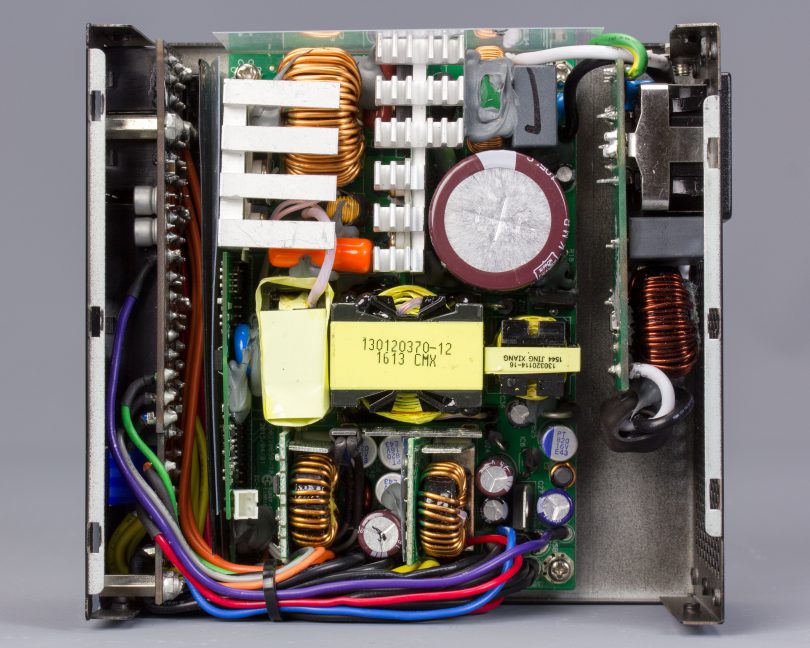
Like the PE-750, the OEM for the PE-550 is Enhance Electronics. Inside it’s quite roomy – so much so, actually, that I think it may be possible to lay the PCB with the AC inlet and filter over top the main PCB, and use a smaller fan in the remaining space to make a SFX version. The SilverStone SX600-G does that and… wait a minute…
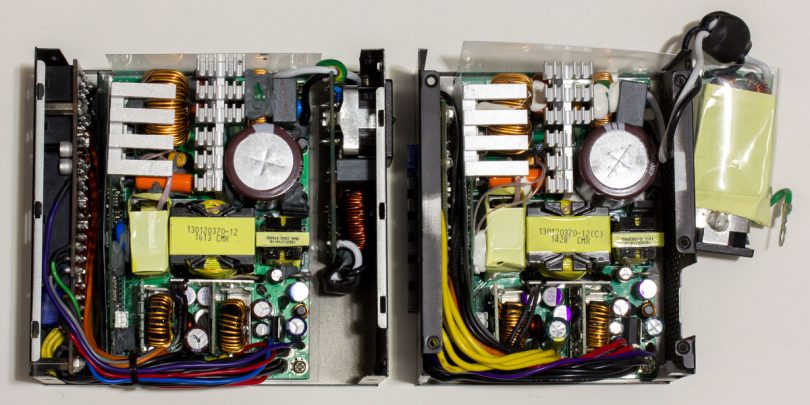
This is the SX600-G! Or at least, it’s the same Enhance platform with better caps (all the electrolytic capacitors I can see are Nippon Chemi-Con caps rated for 105°C) and a slightly lower wattage rating. No wonder the modular connectors are flush, there’s plenty of space to recess them!
This also explains the mediocre semi-passive behavior, as it’s the same that the SX600-G exhibits. In fact, SilverStone has moved away from trying to do semi-fanless functionality with these simple thermistor-based controllers in their recent and upcoming SFF power supplies for this reason. They either reserve that feature for flagship units with more sophisticated controllers (SX700-LPT and SX800-LTI), or just have an always-on fan (SX500-LG v2.0, SX550, SX500-G, and SX650-G) instead.
Conclusion
I have very mixed feelings about the Lian Li PE-550. The PE-750 is a good unit and I was excited that Lian Li had a little brother at a lower wattage and lower price point of $110, with the added bonus of flush modular connectors. It turns out, though, that it’s just the same platform as the SFX SilverStone SX600-G in a SFX-L sized case with a 120mm fan.
To be clear, I don’t think there’s anything inherently wrong with recasing SFX platforms to make SFX-L units if it’s done to fit a 120mm fan for a quieter product. In fact, I’ve been tempted to mod a Corsair SF600 to do just that for kicks.
My disappointment with the PE-550 is that Lian Li choose to recase the SX600-G platform. I bought a SilverStone SX600-G shortly after it released and it served me well powering my workstation for over a year, but I have since retired it now that better options have arrived due to its poor semi-passive behavior. Lian Li did not fix the fan controller when developing the PE-550, so it inherits that same poor semi-fanless behavior: the fan doesn’t stay off for long, once it does start it usually doesn’t stop until the computer is turned off, and there is no hysteresis so the fan cycles up and down at low loads.
For SFF builders where low-load noise is a primary concern (which seems to be pretty common) I just can’t recommend the PE-550 because of that. It’s not as powerful, but the Corsair SF450 should still be more than sufficient for most single-GPU builds – and while I have not personally tested it, from all reports it’s a very quiet unit across most of its load range (not to mention that it’s $20 cheaper than the Lian Li). The $95 SilverStone SX500-LG V2.0 ditches the semi-passive feature of the V1.0/V1.1, since it has similar issues to the SX600-G/PE-550, but its fan starts at 750RPM, so while I wouldn’t expect it to be hugely quieter than the PE-550 at idle, the SilverStone does avoid the issue of the fan ramping up and down.
If at least 550W is required (SLI GTX 1080s?), though, it gets a bit tricky. The Corsair SF600 (review here) is definitely quieter than the PE-550 at low loads, and it’s comparable in price at $119 (and you get a 7-year warranty versus 2 -year for the PE-550). But it’s only a 92mm fan with a somewhat conservative fan curve, so at high loads it will be louder than the PE-550. The SilverStone SX700-LPT (review) and Lian Li PE-750 (review) should both be quieter at low and high loads, but they’re also more expensive than the PE-550 at $150 and $160 respectively.
On the other hand, if low noise is not a priority, the Lian Li PE-550 looks to be a decent mid-range SFX-L unit. Though if noise truly isn’t a concern, the SilverStone SX600-G is currently available from Amazon for $84 after rebate, and has the advantage of a smaller size and slightly higher wattage.
So to conclude this conclusion, I’m glad to see more competition in the SFX-L space, but I think the PE-550 is a decent product marred by a poor semi-fanless implementation. Hopefully this isn’t the last we’ll see of SFX-L power supplies from Lian Li, though, and they’ll have improved iterations in the future.
The Lian Li PE-550 is currently available for $110 on Newegg.
Thoughts? Discuss them in the forum here.
Review sample provided by Lian Li.
Here at SmallFormFactor.net we give manufacturers the ability to be part of the community. We offer a right to reply to hardware reviews. If a manufacturer responds, their comments will be posted here.

